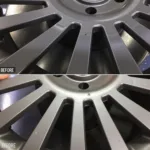A broken car seat frame can be a real pain, literally! It can make driving uncomfortable and even unsafe. But don’t worry, you don’t always need a mechanic to fix it. This guide will walk you through how to repair a car seat frame yourself, saving you money and getting you back on the road in comfort.
Assessing the Damage: Know Your Enemy
Before you start ordering parts, you need to understand the extent of the damage.
- Inspect the frame: Carefully examine the car seat frame for any bends, cracks, or breaks. Pay attention to welds, as they are common weak points.
- Check the Seat Adjustments: See if the seat still adjusts properly. Problems with reclining, moving forward and back, or height adjustment could indicate a frame issue.
- Listen for Noises: Unusual noises like squeaks or clunks when you sit down or adjust the seat can also be a sign of a damaged frame.
 Damaged Car Seat Frame
Damaged Car Seat Frame
Gathering Your Tools and Materials: Be Prepared
Having the right tools and materials on hand will make the repair process much smoother. Here’s what you’ll likely need:
- Basic Hand Tools: Screwdrivers, wrenches, pliers, and a hammer.
- Safety Gear: Work Gloves and Safety Glasses are a must.
- Penetrating Oil: Helps to loosen rusty bolts and screws.
- Replacement Parts: Order these once you know exactly what’s broken. You might need new bolts, brackets, or even sections of the frame itself.
- Metal Repair Products: Depending on the damage, you might need metal filler, epoxy, or welding equipment.
Repairing the Frame: Getting Your Hands Dirty
The repair process will vary depending on the severity of the damage.
1. Minor Bends and Tweaks:
- Support the Frame: Secure the seat frame in a vice or use sturdy supports to prevent further bending.
- Apply Force Gradually: Use a hammer, mallet, or a piece of wood and a hammer to gently bend the frame back into shape. Be patient and work slowly to avoid causing more damage.
2. Cracks and Breaks:
- Cleaning and Preparation: Clean the area around the crack thoroughly with a wire brush or sandpaper to remove rust, paint, or debris.
- Metal Filler or Epoxy: For small cracks, apply a high-quality metal filler or epoxy according to the manufacturer’s instructions. Allow it to dry completely.
- Welding: For serious breaks, welding might be necessary. If you’re not experienced with welding, it’s best to leave this to a professional.
3. Replacing Damaged Parts:
- Disassemble Carefully: If a section of the frame needs replacement, carefully disassemble the seat, taking note of how everything fits together.
- Install New Parts: Install the new parts, ensuring they are properly aligned and secured.
- Reassemble the Seat: Put the seat back together, tightening all bolts and screws securely.
Preventing Future Damage: Be Proactive
Once you’ve gone through the trouble of repairing your car seat frame, you’ll want to prevent future damage. Here are some tips:
- Regular Inspections: Check your car seat frame periodically for signs of wear and tear.
- Avoid Overloading: Don’t put excessive weight on the seat or use it to support heavy objects.
- Careful Entry and Exit: Be mindful of how you get in and out of your car, as repeated forceful motions can stress the frame.
Conclusion: A Job Well Done
Repairing your own car seat frame can be a rewarding experience. Not only will you save money, but you’ll gain a sense of accomplishment. Remember to take your time, follow the instructions carefully, and don’t hesitate to seek professional help if needed. And if you are looking for further advice on car repairs, check out our articles on car leather seats repairs and how to repair foam in a car seat. Safe driving!


